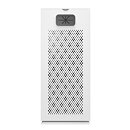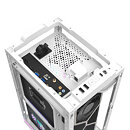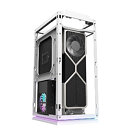Friday, February 5th 2021
darkFlash Releases DLH21 Mini-ITX Case
darkFlash's latest Mini-ITX product, the DLH21, which is now available in stores, adopted a much more unique approach. The idea is to design a simple yet elegant case, which can support 240 mm AIO water coolers, equipped with mesh side-panels. Not only that but also including addressable RGB lighting at the bottom of the case, with has up to 13 different modes, so that no matter what style you are looking for, polished or stylish, it's your call!
The DLH21 has quite a few tricks up its sleeves. First, the size of it is relatively small, because the interior is well thought, adopting a vertical GPU mounting system, which allows the case to extend upwards, saving plenty of desk space. Secondly, all sides include mesh panels with magnetic dust filters, providing unbelievable airflow to support your components. The DLH21 supports 240 mm water cooling, which pushes the performance of the case even higher. Last but not least, the beautiful bottom A-RGB lighting. Controlled by the LED button located on the top I/O port, also synchronizable with your motherboard.Well Designed Compact Size
Giving up on the traditional sports-car-like esports look, darkFlash decided on an almost Nordic design for the DLH21. After stripping away the non-essentials, what remains is a slim and tall, clean and elegant body. The magnetic top panel lets you manage your cables pretty easy, the small yet spacious inside with a 90 mm fan already installed, completely redefines the standard of a luxury ITX case.
Easy Disassemble Meshed Panel
All 4 side panels are meshed and intact by thumb screws, allowing supreme airflow and easy to dispatch for users. The mesh panels all include integrated magnetic dust filters, which are easy to maintain and wash.
Addressable Bottom A-RGB Lighting
A big highlight is the case's bottom A-RGB lighting, which allows you to synchronize with your motherboard. Even if you don't have a motherboard with RGB, you can still control the lighting effect with the pre-installed LED button on the top I/O port, cycling through 13 different lighting effects.
240 mm AIO CPU Water Cooling Ready
The thick and steady inside fits perfectly with your water cooling system, bringing your PC's performance to the next level. Do not be fooled by its cute appearance!
Source:
darkFlash
The DLH21 has quite a few tricks up its sleeves. First, the size of it is relatively small, because the interior is well thought, adopting a vertical GPU mounting system, which allows the case to extend upwards, saving plenty of desk space. Secondly, all sides include mesh panels with magnetic dust filters, providing unbelievable airflow to support your components. The DLH21 supports 240 mm water cooling, which pushes the performance of the case even higher. Last but not least, the beautiful bottom A-RGB lighting. Controlled by the LED button located on the top I/O port, also synchronizable with your motherboard.Well Designed Compact Size
Giving up on the traditional sports-car-like esports look, darkFlash decided on an almost Nordic design for the DLH21. After stripping away the non-essentials, what remains is a slim and tall, clean and elegant body. The magnetic top panel lets you manage your cables pretty easy, the small yet spacious inside with a 90 mm fan already installed, completely redefines the standard of a luxury ITX case.
Easy Disassemble Meshed Panel
All 4 side panels are meshed and intact by thumb screws, allowing supreme airflow and easy to dispatch for users. The mesh panels all include integrated magnetic dust filters, which are easy to maintain and wash.
Addressable Bottom A-RGB Lighting
A big highlight is the case's bottom A-RGB lighting, which allows you to synchronize with your motherboard. Even if you don't have a motherboard with RGB, you can still control the lighting effect with the pre-installed LED button on the top I/O port, cycling through 13 different lighting effects.
240 mm AIO CPU Water Cooling Ready
The thick and steady inside fits perfectly with your water cooling system, bringing your PC's performance to the next level. Do not be fooled by its cute appearance!





27 Comments on darkFlash Releases DLH21 Mini-ITX Case
it's a very traditional layout, but in vertical orientation.
By all accounts, this seems to be the case I have been looking for, for over 10 years.
That combined with limited watercooling makes this a waste imo.
SM570 13L 240mm/40mm or SM580 15L 280mm/45mm cases superior, and have actual flow through ventilation. You can sneak twin rads in too if you use slimmer ones on the bottom.
www.sliger.com/products/cases/sv590/ 360mm rad support. Much better airflow design.
There's a sliger case for just about every use case. Including the cerberus X which is ATX mobo and PSU in space optimised form factor.
Smaller cases can also maintain pressure differentials easier than larger ones due to lower internal air volume. Fans replace entire internal volume of air faster, leading to a better air/component temperature gradient.
As for price, a well designed case will literally last decades and remain effective at its two jobs, protection and cooling.
edit : (It looks like that case is overpriced for the western market (190$ compared to the 70$ asked in asia), so now now it's not a good deal at all)
Sliger cases share the same issue as every other boutique case : they are good for sure, but really expensive, and not everyone got an unlimited budget for such cases, unless they start making compromise on the components. I had my eyes on the SV540 for a while, but the cost added to the issues coming with a riser made me decide agaisnt it. There's an additional cost after a while unless I want to spend my entire life with PCIe 3.0
(edit: The nr200 isn't the sexiest nor the smallest, but it's robust and cool really well, for a very accessible price. You can even air cool if you hate watercooling)
I don't deny the cooling advantage of sandwiche case,(even though it's not as big compared to what case like the m1 or the NR200 can achieve) but the riser that those case need can become a source of headache for those who don't know better, it's not quite a plug and play process. UEFI update will make the motherboard use the fastest pcie spec again, and depending on the motherboard that you got you might not even be able to use an older gen riser. They are still playing catching up with pci 4.0 when 5.0 is coming fast, and anything above 3.0 is expensive to make, motherboards themselve had to increase their pcb layers to support 4.0, so imo a classic layout can be a selling point.
People drop $800-1500 on a GPU then wince at a $200 case that will remain in the build for 5x longer.
ITX Land is a true desert in that price range, (until the meshilicious at least). You either do like everyone in the SFF community those days and get an NR200, or you get a boutique case, because mainstreams case makers don't know how to make a usable ITX case that isn't just a smaller full tower, or under 20 liters. (The phantek shift looks good and is well made, but far too restricted for something that big, The fractal era is a joke, the NZXT H1 catch fire etc...)